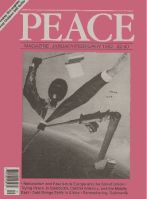
Peace Magazine Jan-Feb 1992, page 26. Some rights reserved.
Search for other articles by Peggy Hope-Simpson here
The Little Peace Maker & Its Warlike Big Brother
WHEN I TOLD FRIENDS that I would be going to "a CSCE Parallel Activities Seminar sponsored by NGOs," their reply was "What's that?" This important political structure has been a well kept secret, which must be made known because, according to External Affairs, "the Conference on Security and Cooperation in Europe (CSCE) is the centrepiece of Canada's European security policy."
In the view of many, the CSCE is the leading edge in the New World Order. It now has 38 member states in Eastern and Western Europe (including three Baltic countries), Canada, and the United States. Its regularly scheduled intergovernmental work moves from Belgrade to Madrid, from Stockholm to Vienna, from Paris to Moscow, and now from Oslo to Helsinki in March 1992. It is an intensely cooperative effort, operating by consensus, and having no legal binding authority. Its man-date deals with security and human rights, economic and environmental cooperation, and the humanitarian dimension.
The CSCE's Stockholm Document of 1987 introduced the remarkable new military language of Confidence-Building Measures and Transparency. This new "behavioral language" actually legitimized the Palme concept of Common Security (1982) and broke open the 15-year logjam around East-West negotiations to reduce armies and conventional weapons in Europe. The Stockholm Agreement also prepared the political ground for the treaty building that marked the end of the Cold War and that rid Europe of the hated strategic Cruise and Pershing missiles, and land-based intermediate nuclear weapons.
M important NGO which supports the CSCE as the determining security structure is the Churches' Human Rights Program for Implementation of the Helsinki Final Act. Bonnie Green, Director of the Office of Church in Society of the United Church of Canada, notes that: "the churches' objective was to indicate to American officials responsible for CSCE that there is region-wide support for the struggle to live in the spirit of Helsinki, and that the American interpretation of security risks is only one amongst many in the CSCE region."
Scilla Elworthy, of the Oxford Research Group, told us that while the budget of NATO is $470 billion, that of the CSCE is $1 million, a ratio of 470,000 to one. Eighty percent of the CSCE's minuscule budget goes to translation services. When one places this allocation of pennies to the CSCE alongside the high hopes invested in it by millions of active supporters, it is again clear that our governments' military spending habits and priorities must be changed in favor of political and economic structures.
It is clear that NATO leaders are attentive to CSCE concerns, and are bringing to our attention, in case we are not aware, the fact that the Helsinki Accords have important things to say, not only about human rights, but also about peace and security. NATO serves to remind us that the Accords defined human rights as a security matter, rather than a humanitarian one. NATO is now creating its new niche as military watchdog over republics that might abuse the rights of minorities, or which attempt to swallow another's territory.
NATO is planning the building of new nuclear air-to surface missiles, the Boeing SCRAM-T, the Martin Marietta SLAT or the French ASMP or ASLP, to be deployed in Europe. These plans are being challenged by international peace movements, notably the NATO Summit Watch which met in Rome in November 1991, parallel to the NATO ministers' Summit. European and Canadian parliamentarians are being petitioned to oppose this unnecessary and unjustifiable development of new nuclear systems, and to push for democratic accountability in defence decision-making.
Let's face it-NATO is not going to fade away overnight. But we can work to make sure it gets leaner, that it works within a democratic mandate and under the rule of law. Lacking an enemy now, it could be required by its member governments to adopt common security principles. As Scilla Elworthy suggested, we could assess what tasks NATO does competently and have NATO transfer those skills and resources to a permanent U.N. Peacekeeping Force, under international law. In fact, isn't this something that Canada and possibly the Nordics could begin to put into place?
Peggy Hope-Simpson is an activist and observer of international affairs.

Peace Magazine Jan-Feb 1992, page 26. Some rights reserved.
Search for other articles by Peggy Hope-Simpson here